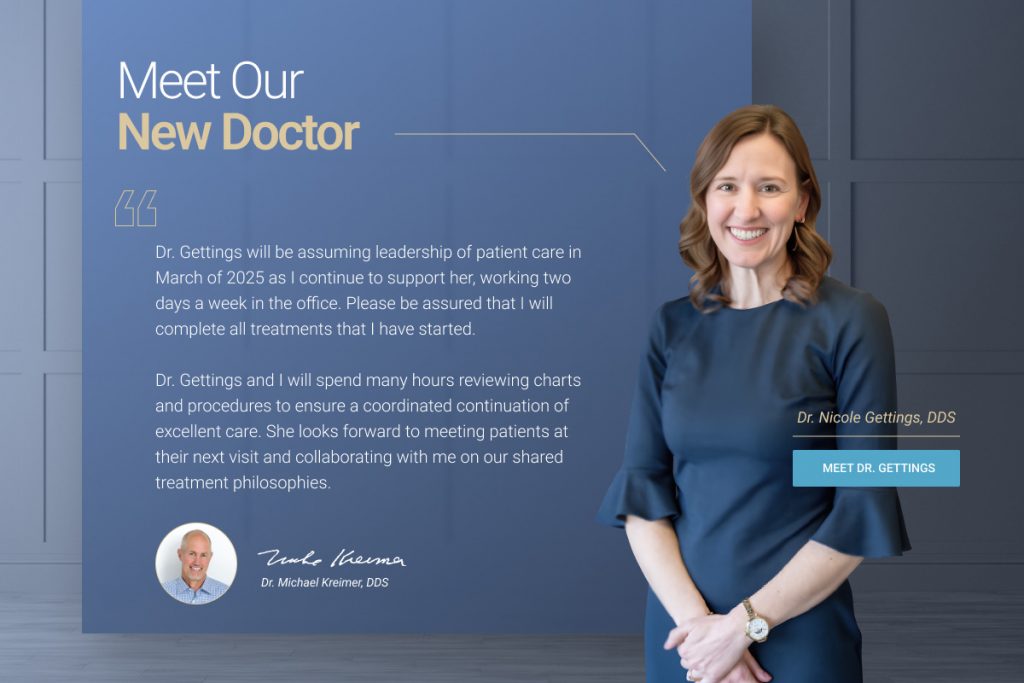The Quick and Easy Smile Makeover
Imagine being able to improve your smile in just one quick, painless dental visit. With modern advances in cosmetic dentistry, you can do just that with dental bonding. Dental bonding uses tooth-colored composite resin material to conceal flaws like chips, gaps, stains, and discolorations on your teeth. The result is a smile makeover that looks completely natural.
Our Loveland, OH, cosmetic dentist, Dr. Michael Kreimer, is proud to provide dental bonding for patients seeking a way to conceal flaws fast. Discover why dental bonding has become a popular choice for minor cosmetic treatments thanks to its convenience, affordability, and lasting results.
What Is Dental Bonding?
Dental bonding is a procedure where tooth-colored composite resin material is applied to “fill in the blanks” and improve the appearance of teeth. One of the most common uses of bonding is to fill in gaps between front teeth, but it can also be used to repair chips and cracks, change the shape or size of teeth, and cover stains or discolorations.

When Dental Bonding Is Used?
Dental bonding is an ideal treatment when there are minor flaws affecting the look of your smile. Some of the most frequent uses of dental bonding include:
- Filling in Gaps or Spaces Between Teeth — Composite resin can create an even line of teeth. This is done when there is minor crowding or small gaps due to missing teeth.
- Repairing Chipped or Cracked Teeth — Small chips and cracks can be fixed by filling in the missing tooth structure with bonding material. This restores strength and appearance.
- Changing the Shape or Size of Teeth -—Teeth can be reshaped with dental bonding. For example, we can use bonding to correct uneven teeth or make teeth look longer.
- Covering Discolored or Stained Teeth — Composite resins come in natural tooth shades and can mask discolorations like yellowing or stained spots on teeth.
The Dental Bonding Procedure
Applying dental bonding is a multi-step process performed by your dentist. Dr. Michael Kreimer outlines the basic bonding steps:
- Preparation — The teeth are roughened up and a conditioning liquid is applied so the bonding material adheres properly.
- Application of Composite Resin — Dr. Kreimer selects a composite shade that matches your natural teeth. The material is sculpted and contoured over the teeth.
- Reshaping and Contouring — While the material is still soft, our Loveland dentist finely shapes it for a natural look and feel.
- Hardening with UV light — He’ll use a special UV light to harden and cure the composite resin.
- Polishing and Finishing — Your Loveland dentist carefully polishes and refines the bonding material for a smooth finish.
Advantages of Dental Bonding
Many benefits make dental bonding a popular choice, according to Dr. Kreimer:
- Only a minimal amount of tooth needs to be removed.
- Bonding costs less than other cosmetic treatments.
- This procedure can often be completed in one office visit.
- Composite resin comes in life-like tooth shades.
- Bonded resins create a protective layer over teeth to strengthen and protect them.
Caring for Your Bonded Teeth
With proper care and maintenance, your restoration can last from five to seven years, maybe even longer. To get the most longevity out of dental bonding, maintain proper oral hygiene.
- Brush and floss thoroughly to prevent decay under the bonding.
- You should avoid biting hard objects since they can crack the composite material.
- Don’t forget to see your dentist regularly. Dr. Kreimer can examine the bonding and replace it if needed.
Frequently Asked Questions
How long does a dental bonding procedure take?
A single dental bonding procedure usually takes 30-60 minutes to complete. However, if you are getting bonding on multiple teeth, the appointment may last up to two hours. Your dentist will provide an estimated timeline for your treatment.
Does getting dental bonding hurt?
Patients typically don’t report feeling pain during the bonding process. Your dentist will numb the treatment area if any drilling is needed to prepare the teeth. You may feel some sensitivity to hot and cold after the numbing wears off.
Can dental bonding be used on back teeth?
While less common, dental bonding can also be used on back molars and premolars. It can fill cavities, repair cracks or chips, and rebuild worn teeth in the back of the mouth. The bonding is shaped and contoured just like the front teeth.
Can dental bonding be removed?
Yes, dental bonding isn’t permanent like crowns or veneers. Your dentist can safely drill away the resin material and lift it off your teeth if you wish to have it removed in the future.
Get the Smile You’ve Always Wanted
If you are unhappy with small flaws in your smile, dental bonding could be the ideal solution for you. Minor gaps, chips, cracks, and discolorations can be concealed through this affordable and non-invasive treatment.
Call our office at (513) 677-3656 to schedule a consultation with our Loveland dentist to determine if you’re a candidate for dental bonding. We proudly provide services to new and returning patients in Cincinnati and surrounding areas like Murdock, Landen, Mason, and Reading, OH.


